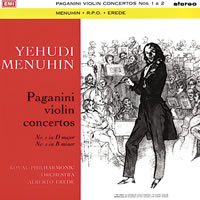x
You have added Paganini: Violin Concerto Nos. 1 & 2 ~ LP x1 180g to your shopping cart!
"The first movements of both Concertos open with full-sized tuttis (somewhat cut in this recording, as is usual in performance today) which introduce the themes, vigorous or tuneful, which are later to be turned to account by the soloist and from which he develops the amazing display of virtuosity in which Paganini specialized. Throughout, the soloist is treated by the orchestra somewhat in the manner of a prima donna in the Italian operas of the period. He can do no wrong; if he wishes to linger on an especially beautiful high note the orchestra will wait, if the reverse, the orchestra will obediently hurry on with him. Both slow movements open with dramatic strokes which are followed by pathetic and expressive melodies in the high register of the solo violin, and the final movements of both works are rondos. That of the First Concerto has a particularly charming and capricious theme and great brilliance in the episodes. The Rondo of the Second Concerto is entitled by the composer La Campanella ("The Little Bell") - Paganini marks three very high harmonic notes which occur twice just before the end of the principal theme with the word cloche. Again great brilliance, as well as more expressive themes alternate with the main one. The cadenza played by Menuhin in the First Concerto is by Emile Sauret, a late 19th century violinist; that in the Second Concerto was written specially for Menuhin by Adolph Baller, one of his most valued accompanists." - Kinloch Anderson, 1961
Track Listing
Concerto No. 1 in D major, Op. 6
Band 1 - First Movement: Allegro maestoso
Band 2 - Second Movement: Adagio espressivo
Band 3 - Third Movement: Rondo (Allegro spiritoso)
Concerto No. 2 in B minor, Op. 7
Band 1 - First Movement: Allegro maestoso
Band 2 - Second Movement: Adagio
Band 3 - Third Movement: Rondo (''La Campanella'')
Track Listing
Concerto No. 1 in D major, Op. 6
Band 1 - First Movement: Allegro maestoso
Band 2 - Second Movement: Adagio espressivo
Band 3 - Third Movement: Rondo (Allegro spiritoso)
Concerto No. 2 in B minor, Op. 7
Band 1 - First Movement: Allegro maestoso
Band 2 - Second Movement: Adagio
Band 3 - Third Movement: Rondo (''La Campanella'')
Customer Reviews
LEAVE A REVIEW

